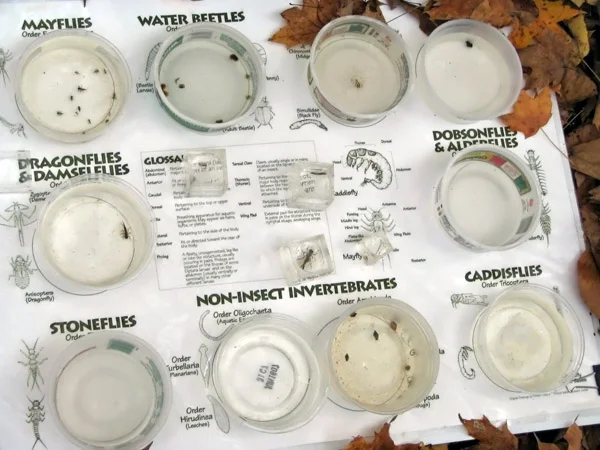Stream Investigations
(Recommended for 4th & 5th Grades)
Combine research with personal field observations! The day begins with a active demonstration that introduces students to life in a lotic (flowing) water environment, some of the special adaptations organisms need to survive in moving water, and the importance of the the stream side plants (riparian buffer). Students then hike through the riparian buffer forest to the beautiful East Branch creek where they assess the life-sustaining components of the stream community, collect and identify macroinvertebrate speciments, and trace the flow of energy. Ater a lunch break in our picnic facilities, students play a game that teaches new information and reinforces important vocabulary and concepts. An TeachCam session, allows students to a variety of aquatic organisms larger than life, identify the special features which help them to survive, learn more about their life cycles and how they can be used to determine stream health.
Meets PDE Academic Standards: See list below!
Schedule:
2 hour morning lesson
lunch break
1.5 hour learning and activity stations
Wrap-up
Fee:
$16 per student ($160 minimum fee per class)
For more information or for reservations contact: PWC Education Department at education@perkiomenwatershed.org
What the teachers are saying:
Thank you for a day of learning in the real world! It is obvious that the leaders are knowledgeableand have a love for children! Hopefully their passion to care for our environment will be something students will pick up as foremost today.
- 5th Grade Teacher, West Broad Street Elementary
The program fit perfectly with our curriculum! The students loved the hands-on activities. This was a great learning experience!
- 5th Grade Teacher, West Broad Street Elementary
My students said it was the best field trip ever!
- 5th Grade Teacher, Lower Salford Elementary
What the students are saying:
I loved how you did the activity with us before we went in the stream. It opened up a world of understanding to me. I love how you are using your time and making an effort to save the environment. It shows. It was cool how we got to take a closer look at our world through the microscope. I understand how a mayfly nymph breathes through his abdomen because of that. Please keep doing this for many more years to come - it's worth it.
5th Grade Student, Lower Salford Elementary
PA STEELS Standards covered in this lesson:
3.1.4.A Construct an argument that plants and animals have internal and external structures that function to support survival, growth, behavior, and reproduction.
3.1.4.B Use a model to describe that animals receive different types of information through their senses, process the information in their brain, and respond to the information in different ways
3.1.5.B Develop a model to describe the movement of matter among plants, animals, decomposers, and the environment.
3.3.5.C Develop a model using an example to describe ways the geosphere, biosphere, hydrosphere, and/or atmosphere interact.
3.4.3-5.A Analyze how living organisms, including humans, affect the environment in which they live, and how their environment affects them.
3.4.3-5.E Construct an argument to support whether action is needed on a selected environmental issue and propose possible solutions.
3.4.3-5.F Critique ways that people depend on and change the environment.
3.5.3-5.E Explain why responsible use of technology requires sustainable management of resources.
PDE Academic Standards covered by this lesson include:
3.1.4.A1 - Classify plants and animals according to the physical characteristics that they share.
3.1.4.A2 - Describe the different resources that plants and animals need to live.
3.1.4.A5 - Describe common functions living things share to help them function in a specific environment.
3.1.4.B5 - PATTERNS - Identify observable patterns in the physical characteristics of plants or groups of animals.
3.1.4.C2 - Describe plant and animal adaptations that are important to survival.
3.3.4.A4 - Recognize Earth’s different water resources, including both fresh and saltwater.
4.1.4.A- Explain how living things are dependent upon other living and nonliving things for survival.
4.1.4.B - Identify how matter cycles through an ecosystem.
4.1.4.C - Explain how most life on earth gets its energy from the sun.
4.1.4.D - Explain how specific adaptations can help organisms survive in their environment.
4.1.4.E - Explain that ecosystems change over time due to natural and/ or human influences.
4.2.4.A - Describe the physical characteristics of a watershed.
4.2.4.C - Explain how freshwater organisms are adapted to their environment. Explain the life cycles of organisms in a freshwater environment
Standard - 4.2.4.D - Distinguish between scientific fact and opinion. Ask questions about objects, organisms and events. Understand that all scientific investigations involve asking and answering questions and comparing the answer with what is already known. Plan and conduct a simple investigation and understand that different questions require different kinds of investigations.Use simple equipment (tools and other technologies) to gather data and understand that this allows scientists to collect more information than relying only on their senses to gather information. Use data/evidence to construct explanations and understand that scientists develop explanations based on their evidence and compare them with their current scientific knowledge. Communicate procedures and explanations giving priority to evidence and understanding that scientists make their results public, describe their investigations so they can be reproduced and review and ask questions about the work of other scientists.
4.5.4.C - Describe how human activities affect the environment.
3.1.5.A2 - Describe how life on earth depends on energy from the sun.
3.1.5.A3 - Compare and contrast the similarities and differences in life cycles of different organisms.
4.1.5.A - Describe the roles of producers, consumers, and decomposers within a local ecosystem.
4.1.5.B - Explain the basic components of the water cycle.
4.2.5.C - Identify physical, chemical, and biological factors that affect water quality.
4.4.5.A - Explain why animal production is dependent upon plant production.
4.5.5.C - Explain the difference between point and non-point source pollution.
3.1.6.A2 - Describe how energy derived from the sun is used by plants to produce sugars (photosynthesis) and is transferred within a food chain from producers (plants) to consumers to decomposers.
3.3.6.A4 - Describe how water on earth cycles in different forms and in different locations, including underground and in the atmosphere.
4.2.6.A - Identify the five major watersheds of Pennsylvania.
4.2.6.C - Identify natural and human-made factors that affect water quality.








